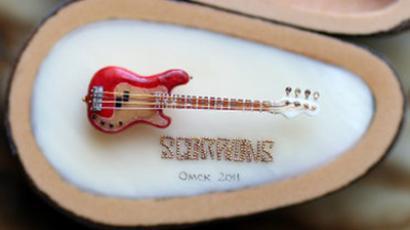Each book consists of several pages made of extremely thin polyester film with letters printed through the medium of lithography. The most challenging task, according to the artist, was to bind the pages with two ‘rings’ made of five micron tungsten wires that would make his works look like real books. In order to turn the pages, the reader has to use a sharp needle.
To accomplish this he cut two holes in the film, each about 10 micron in diameter. Then he cropped the film and glued it to the white paint coating (about six to eight micron thin), leaving the holes empty. Following that the master tailored the film to the book size and installed the rings into the respective gaps to complete the masterpieces.
“The main difficulty is your own heartbeat, a heartbeat that reaches your finger tips and gets passed on to the instrument, which, in turn, starts fluttering in tune with the heartbeat. You only have half of a second to make the required motion,” Aniskin told RT.
“I do everything myself. My tools resemble those used for carving wood, although they are very small and can fit into a palm.”
Aniskin says it took him years to develop the method and technology to create his masterpieces, and months to create each miniature object.
The books are being displayed on golden plates fitted into the center of poppy seeds cut open. On the upper half of the plate Aniskin put the book itself, while separate pages from the books with letters inscribed could be observed below. This trick would allow potential readers to understand the contents of the book without opening it.
One of the books is called ‘Levsha’, a reference to the famous Russian tale about a skillful left-handed man named Levsha who shod a flea with horse-shoes. The Aniskin`s book lists the names of the masters who managed to achieve similar skill, including that of himself. On the pages of the second book, entitled “Alphabet” the artist depicted the letters of the Russian alphabet.
“I had two goals. The book had to have a sensible content and be less than 100 micron in size. It also had to be possible to turn the pages of it. I thought of two topics, the first being the list of last names of masters who managed to shoe a flea, and the second being the alphabet. The first book has four pages. The second has seven,” he said.
The books’ exact measurements are 0.07 by 0.09 millimeters, which is roughly 88 times smaller than the official record held by Japanese publishers, which has the measurement 0.74 х 0.75 millimeters.
Aniskin, PhD in Physics and Mathematics, discovered his passion for microminiatures in 1998 after he borrowed a book called “Secrets of Invisible Masterpieces” from his university library. Aniskin, who was contemplating a career as a jeweler at the time, thought it was about the jewelry industry. However, it turned out that the book was devoted to the Soviet microminiature craft.
“It all started with a book called “Secrets of Invisible Masterpieces”. It is a collection of stories about the works of USSR miniature artists. After a while I started to get the hang of it and began exhibiting my works”.
When describing the masterpieces he made, he mentioned he had three main goals.
“The first task is the creation of a miniature book, the second is a moving miniature and the third one is the smallest man-made work piece. I began to implement these ideas with a book,” the artist said.
Since then he has created series of exquisite microminiatures, with some of them being exhibited at “Russian Levsha” museum of microminiature art in St. Petersburg.
Among his most famous works are a caravan of camels inside the eye of a needle, a scene from Winnie the Pooh and set of chess pieces placed on poppy seeds, and a copy of a Sochi Olympic medal, which in only 2 milliliters in diameter. All his works are hand-made with only the help of a microscope.
When asked about his vision, the artist said that it was slowly deteriorating.
“My vision is bad, it has been declining. But it is age-related. The vision becomes worse when you work with a microscope and it is tuned incorrectly, or if the lighting is bad,” he said.
Aniskin said that next week he would submit an application and request that his craftworks be put into the Guinness Book of World Records.
Source Article from https://www.rt.com/news/334197-russian-record-miniature-book/?utm_source=rss&utm_medium=rss&utm_campaign=RSS
Related posts:
Views: 0
 RSS Feed
RSS Feed















 March 2nd, 2016
March 2nd, 2016  Awake Goy
Awake Goy 
 Posted in
Posted in  Tags:
Tags: 
















